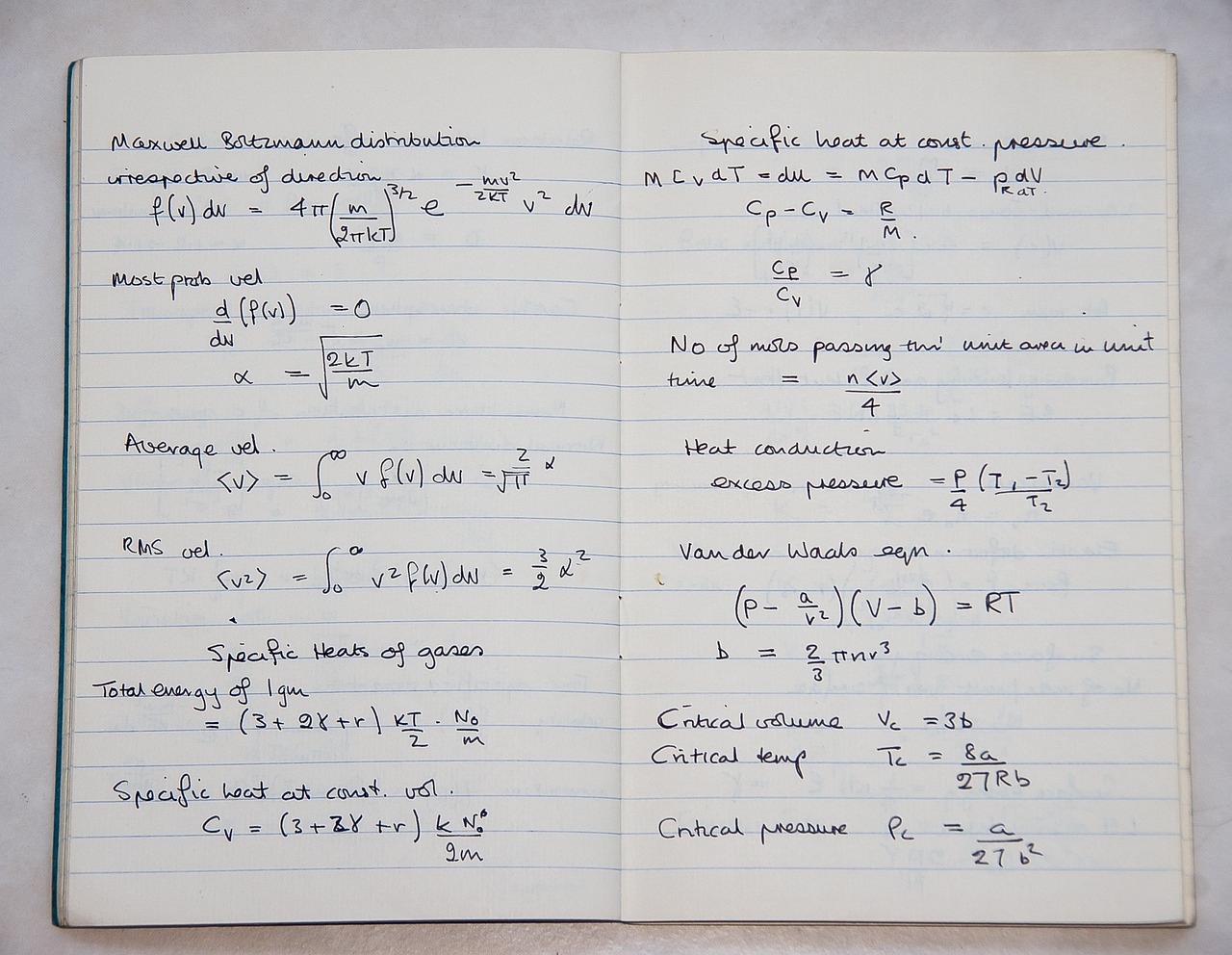Theoretical Physics - The Fusion of Philosophy and Science
The journey through the realms of theoretical physics is akin to embarking on an adventure where philosophy and science intertwine seamlessly. At the heart of this exploration lies the quest to understand the universe, its origins, and the fundamental principles that govern everything from the smallest particles to the vastness of space. But what exactly makes theoretical physics so captivating? Is it the tantalizing mysteries that lie just beyond our grasp, or the profound questions that challenge our very understanding of reality?
Theoretical physics serves as a bridge, connecting the abstract world of ideas with the tangible universe we inhabit. It compels us to ponder existential questions such as: What is the nature of time? Is the universe infinite? And, how do we reconcile the seemingly chaotic behavior of particles at the quantum level with the orderly laws of classical physics? Each question opens a Pandora's box of philosophical inquiry, revealing the intricate dance between scientific rigor and philosophical contemplation.
Consider, for instance, the famous thought experiment of Schrödinger's cat. This hypothetical scenario invites us to explore the paradoxes of quantum mechanics while simultaneously challenging our perceptions of reality. Here, the cat exists in a superposition of states—both alive and dead—until observed. This peculiar situation not only illustrates the foundational principles of quantum theory but also prompts us to question the nature of observation and existence itself. It’s as if we are peering into the very fabric of reality, only to find that our understanding is constantly evolving.
Moreover, the fusion of theoretical physics and philosophy extends beyond mere questions; it influences the methodologies scientists employ in their research. Theoretical physicists often rely on mathematical frameworks to describe complex phenomena, but these frameworks are not just tools—they embody philosophical assumptions about the nature of reality. For example, the concept of symmetry in physics is deeply rooted in both mathematics and philosophical thought, shaping our understanding of fundamental forces and particles.
As we delve deeper into this fascinating interplay, we uncover how theoretical physics not only seeks to explain the universe but also reflects our human desire to comprehend our place within it. The challenges posed by black holes, dark matter, and the fabric of spacetime compel us to look beyond empirical evidence and engage with the philosophical implications of our findings. This ongoing dialogue between theory and philosophy enriches our understanding, allowing us to appreciate the complexity and beauty of the cosmos.
- What is theoretical physics? - Theoretical physics is a branch of physics that uses mathematical models and abstractions to explain and predict natural phenomena.
- How does philosophy relate to theoretical physics? - Philosophy explores the foundational questions and implications of theories in physics, enhancing our understanding of concepts like reality and existence.
- Can theoretical physics provide answers to existential questions? - While theoretical physics can inform our understanding of the universe, many existential questions may remain unanswered, inviting philosophical exploration.
- What role does mathematics play in theoretical physics? - Mathematics serves as the language of theoretical physics, allowing scientists to formulate theories and models that describe physical laws.

The Historical Context of Theoretical Physics
To truly grasp the essence of theoretical physics, we must embark on a journey through time, tracing its roots back to the ancient philosophers who first pondered the nature of existence. The interplay between philosophy and science has been a long and intricate dance, with each discipline influencing the other in profound ways. Think of it as a grand tapestry, where each thread represents a different idea or discovery, woven together to form the rich fabric of modern scientific thought.
The origins of theoretical physics can be traced back to the ancient Greeks, where thinkers like Aristotle and Plato laid the philosophical groundwork for understanding the universe. They asked questions that still resonate today: What is the nature of reality? How do we know what we know? These inquiries were not merely abstract; they sparked a quest for knowledge that would eventually lead to the scientific revolution. Fast forward to the 17th century, and we see figures like Galileo Galilei and Isaac Newton stepping onto the stage, armed with mathematics and a desire to quantify the natural world.
Newton's laws of motion and universal gravitation represented a monumental shift in how we perceive the cosmos. He bridged the gap between philosophical speculation and empirical observation, establishing a framework that would dominate scientific thought for centuries. The Enlightenment period further fueled this intellectual fire, as thinkers began to advocate for reason and evidence as the cornerstones of knowledge. This was a time when the scientific method emerged, emphasizing the importance of experimentation and observation in validating theories.
As we moved into the 19th century, the landscape of theoretical physics continued to evolve. The advent of thermodynamics and electromagnetism introduced new concepts that challenged existing paradigms. Scientists like James Clerk Maxwell and Ludwig Boltzmann expanded our understanding of energy and matter, illustrating how mathematics could be used to describe physical phenomena with unprecedented precision. This period marked a significant transition from classical physics to the realms of quantum mechanics and relativity, where the philosophical implications of these theories began to stir debates that continue to this day.
In the 20th century, the fusion of theoretical physics and philosophy reached new heights. Thinkers like Albert Einstein and Niels Bohr not only revolutionized our understanding of space and time but also posed questions about the fundamental nature of reality itself. Their work prompted discussions about determinism, probability, and the very fabric of the universe. This era was characterized by a growing recognition that our understanding of the universe is not merely a collection of facts but a complex interplay of ideas, theories, and philosophical interpretations.
Today, the historical context of theoretical physics serves as a reminder of how far we have come and how intertwined our quest for knowledge is with philosophical inquiry. The questions posed by early thinkers continue to inspire modern scientists, urging them to explore the unknown and challenge the boundaries of human understanding. In essence, the evolution of theoretical physics is not just a story of scientific progress; it is a testament to humanity's enduring curiosity and the deep-rooted connection between philosophy and science.
As we reflect on this rich history, we can appreciate the profound implications it has for our understanding of reality. The journey from ancient philosophy to modern theoretical physics is a testament to the power of inquiry and the relentless pursuit of knowledge that defines the human experience.

The Role of Mathematics in Theoretical Physics
Mathematics is often described as the language of the universe, and in the realm of theoretical physics, it takes on a role that is nothing short of pivotal. Imagine trying to describe the intricate dance of celestial bodies or the behavior of subatomic particles without the precise vocabulary that mathematics provides. It's like trying to paint a masterpiece without a brush; the nuances and details would be lost. Theoretical physicists rely heavily on mathematical frameworks to articulate their ideas, construct models, and make predictions about the physical world.
At its core, mathematics offers a systematic way to represent complex concepts in a clear and unambiguous manner. Whether it's through algebra, calculus, or geometry, these mathematical tools allow physicists to express relationships between different physical quantities. For instance, consider Newton's laws of motion, which are elegantly encapsulated in mathematical equations that describe how objects move in response to forces. Without the mathematical formulation, these laws would be mere observations without the power to predict future behavior.
Moreover, mathematics enables physicists to create models that simulate real-world phenomena. These models are not just abstract constructs; they are essential for understanding everything from the behavior of gases in a container to the dynamics of galaxies. The equations derived from these models can be incredibly complex, yet they provide a framework through which scientists can analyze and interpret data. For example, in quantum mechanics, the Schrödinger equation is a fundamental equation that describes how the quantum state of a physical system changes over time, illustrating the profound connection between mathematics and the fundamental laws of nature.
Mathematical models serve as the backbone of theoretical physics. They allow scientists to simulate scenarios that may be impossible or impractical to test in a laboratory setting. Through these models, researchers can explore a variety of physical systems and predict their behavior under different conditions. For example, climate models use complex mathematical equations to simulate atmospheric conditions, helping us understand and predict climate change. This predictive power is crucial in many fields, including astrophysics, where models are used to simulate the evolution of stars and galaxies over billions of years.
When discussing mathematical models in physics, it is essential to understand the distinction between linear and nonlinear models. Linear models are simpler and often easier to solve, making them useful for systems where relationships between variables are proportional. However, many physical phenomena are inherently nonlinear, meaning that small changes in input can lead to disproportionately large changes in output. This complexity often requires advanced mathematical techniques and numerical methods to analyze, as nonlinear systems can exhibit chaotic behavior that challenges our understanding of predictability.
One of the most fascinating applications of mathematics in theoretical physics is found in statistical mechanics. This branch of physics employs probability theory to explain how macroscopic properties of materials arise from the collective behavior of microscopic particles. For instance, while we may observe the temperature of a gas, that temperature is a statistical average derived from the chaotic motion of countless individual molecules. By applying mathematical principles of probability, physicists can bridge the gap between the micro and macro worlds, gaining insights into phenomena such as phase transitions and critical points.
In essence, the role of mathematics in theoretical physics is not just about crunching numbers or solving equations; it is about unraveling the mysteries of the universe. Each equation, each model, is a step closer to understanding the fundamental principles that govern everything from the tiniest particles to the vastness of the cosmos. As we continue to explore the depths of theoretical physics, mathematics will remain our most trusted ally, guiding us through the complexities of reality.
- Why is mathematics considered the language of physics? Mathematics provides a precise and unambiguous way to describe physical phenomena, allowing scientists to formulate theories and predict outcomes.
- What are some examples of mathematical models in physics? Examples include Newton's laws of motion, the Schrödinger equation in quantum mechanics, and climate models used to predict weather patterns.
- What is the difference between linear and nonlinear models? Linear models are simpler and proportional, while nonlinear models exhibit more complex behavior and can lead to chaotic outcomes.
- How does statistical mechanics relate to probability? Statistical mechanics uses probability theory to explain the macroscopic properties of systems based on the behavior of their microscopic constituents.

Mathematical Models and Their Applications
Mathematical models are the backbone of theoretical physics, acting as the bridge between abstract concepts and the tangible universe we inhabit. These models allow physicists to translate complex phenomena into mathematical language, enabling them to analyze, predict, and understand the underlying principles governing the physical world. Imagine trying to describe the motion of planets without equations; it would be like trying to navigate a ship without a compass. Mathematical models provide that essential guidance, helping us chart the vast seas of the cosmos.
One of the most significant applications of mathematical models is in simulating real-world systems. For instance, consider climate modeling. Scientists use intricate mathematical equations to represent atmospheric processes, ocean currents, and solar radiation. By inputting various variables, they can predict future climate conditions, which is crucial for understanding climate change and its potential impacts on our planet. This predictive power is not limited to climate science; it extends to fields such as quantum mechanics, astrophysics, and particle physics.
Moreover, mathematical models can be categorized into different types based on their characteristics. The two primary categories are linear and nonlinear models. Linear models assume a direct proportionality between variables, making them relatively simple to solve and analyze. In contrast, nonlinear models account for complex interactions where changes in one variable can lead to unpredictable outcomes in another. This distinction is crucial because many real-world phenomena, such as weather patterns or population dynamics, are inherently nonlinear and require sophisticated approaches to model accurately.
Another fascinating aspect of mathematical models is their role in statistical mechanics. This branch of physics uses probability theory to address the behavior of large ensembles of particles. For example, while a single molecule might exhibit chaotic motion, the collective behavior of a vast number of molecules can be predicted using statistical methods. This approach not only simplifies the analysis of complex systems but also provides insights into macroscopic phenomena like temperature and pressure, bridging the gap between the microscopic and macroscopic worlds.
To further illustrate the significance of mathematical models, let's consider a few specific applications:
- Fluid Dynamics: Mathematical models help in understanding how fluids behave under various conditions, which is essential in engineering and meteorology.
- Quantum Field Theory: This area relies on complex mathematical frameworks to describe the interactions of subatomic particles.
- General Relativity: Einstein's equations, which describe the gravitational forces in the universe, are a prime example of how mathematics can shape our understanding of space and time.
In summary, mathematical models are not just abstract tools; they are vital for exploring the mysteries of the universe. They enable scientists to create simulations, make predictions, and ultimately deepen our understanding of the fundamental laws of nature. As we continue to refine these models with advancements in technology and computational power, the potential for new discoveries in theoretical physics becomes even more exciting.
- What is a mathematical model?
A mathematical model is a representation of a system or phenomenon using mathematical concepts and language, allowing for analysis and predictions about its behavior.
- Why are mathematical models important in physics?
They provide a structured way to understand complex systems, enabling predictions and insights that can be tested through experiments.
- What is the difference between linear and nonlinear models?
Linear models assume a direct relationship between variables, while nonlinear models account for more complex interactions that can lead to unpredictable outcomes.
- How does statistical mechanics relate to mathematical modeling?
Statistical mechanics uses probability theory to predict the behavior of large systems, bridging the gap between microscopic and macroscopic phenomena.

Linear vs. Nonlinear Models
When delving into the realm of theoretical physics, one cannot overlook the pivotal distinction between linear and nonlinear models. These models serve as the backbone for understanding complex systems, and their differences are not just academic; they have profound implications for how we interpret the universe around us. Imagine trying to navigate a winding path in a dense forest versus a straight road. The former is akin to nonlinear dynamics, where the journey is fraught with unpredictability, while the latter represents linear models, characterized by simplicity and predictability.
Linear models operate under the assumption that relationships between variables are proportional and additive. This means that changes in input lead to proportional changes in output, making them relatively straightforward to analyze. For instance, in classical mechanics, the motion of an object under constant acceleration can be described by linear equations. The beauty of linearity lies in its simplicity; it's like baking a cake with a clear recipe—add the ingredients in specific amounts, and you get a predictable result.
On the flip side, nonlinear models introduce a layer of complexity that can be both fascinating and daunting. In these models, small changes in initial conditions can lead to vastly different outcomes, a phenomenon known as sensitivity to initial conditions. This is often illustrated by the butterfly effect, where the flapping of a butterfly's wings might set off a chain of events leading to a distant storm. Nonlinear systems are akin to a chaotic dance, where every twist and turn can lead to unexpected results. They are essential in fields such as fluid dynamics, climate modeling, and even economics, where interactions are anything but straightforward.
To further clarify the differences between these two types of models, consider the following table:
| Characteristic | Linear Models | Nonlinear Models |
|---|---|---|
| Relationship Type | Proportional | Complex and unpredictable |
| Equation Form | y mx + b | y f(x) (no fixed form) |
| Predictability | High | Low |
| Applications | Simple motion, circuits | Weather systems, population dynamics |
It's worth noting that while linear models are easier to work with mathematically, they often fall short when it comes to capturing the intricacies of real-world phenomena. Nonlinear models, despite their complexity, provide a richer framework for understanding systems where interactions are interdependent and multifaceted. This complexity is why scientists often resort to numerical simulations and computational methods to explore nonlinear dynamics, as analytical solutions may be impossible to obtain.
In conclusion, the distinction between linear and nonlinear models is not just a matter of mathematical preference; it reflects a deeper understanding of how we perceive and interact with the universe. As we continue to explore the mysteries of theoretical physics, recognizing the implications of these models will be crucial in our quest for knowledge. So, whether you're a budding physicist or simply a curious mind, grasping the differences between these models can illuminate the path to comprehending the complexities of reality.
- What are linear models used for in physics?
Linear models are often used to describe systems where relationships between variables are simple and predictable, such as in basic mechanics and electrical circuits. - Why are nonlinear models important?
Nonlinear models are essential for understanding complex systems where interactions are interdependent, such as in climate systems or biological populations. - Can linear models be applied to nonlinear systems?
While linear models can provide some insights, they often fail to capture the full dynamics of nonlinear systems, leading to incomplete or inaccurate predictions.

Statistical Mechanics and Probability
Statistical mechanics is a fascinating branch of theoretical physics that provides a framework for understanding the behavior of large systems composed of many particles. It essentially acts as a bridge between the microscopic world of individual particles and the macroscopic world of observable phenomena. By employing probability theory, statistical mechanics allows scientists to make sense of the chaotic behavior of particles and predict how they will behave collectively. Imagine trying to predict the weather; while you can't know the exact position of every molecule in the air, you can use statistical methods to forecast trends based on past data. This analogy beautifully illustrates how statistical mechanics operates in the realm of physics.
At its core, statistical mechanics relies on the idea that while individual particles may behave randomly, their collective behavior can be described statistically. This leads us to the concept of ensembles, which are large collections of systems that share certain macroscopic properties. The most common types of ensembles include:
- Microcanonical Ensemble: This describes an isolated system with fixed energy, volume, and number of particles.
- Canonical Ensemble: In this case, the system can exchange energy with its surroundings, maintaining a constant temperature.
- Grand Canonical Ensemble: This ensemble allows for both energy and particle exchange, making it useful for understanding systems in equilibrium with a reservoir.
Through these ensembles, statistical mechanics provides powerful tools for calculating thermodynamic quantities such as temperature, pressure, and entropy. For instance, the Boltzmann distribution is a fundamental result that gives the probability of a system being in a certain state based on its energy. This distribution is crucial for explaining phenomena such as the distribution of speeds among gas molecules in a container. The formula is expressed as:
P(E) (1/Z) * e^(-E/kT)
Where:
- P(E): Probability of a system being in a state with energy E
- Z: Partition function, a normalization factor
- k: Boltzmann constant
- T: Absolute temperature
One of the most intriguing aspects of statistical mechanics is its ability to explain the emergence of macroscopic properties from microscopic laws. For example, consider how temperature arises from the random motion of particles. As the average kinetic energy of particles increases, so does the temperature of the system. This connection between the microscopic and macroscopic worlds raises profound questions about the nature of reality and our understanding of physical laws.
In conclusion, statistical mechanics not only enhances our understanding of physical systems but also serves as a testament to the power of probability in explaining complex phenomena. By recognizing the inherent randomness in particle behavior and applying statistical methods, physicists can uncover the underlying order in what might initially appear to be chaos. This interplay between randomness and order is a central theme in both statistical mechanics and the broader field of theoretical physics.
What is statistical mechanics?
Statistical mechanics is a branch of theoretical physics that uses probability theory to describe the behavior of large systems of particles, linking microscopic properties to macroscopic phenomena.
How does statistical mechanics relate to thermodynamics?
Statistical mechanics provides a microscopic foundation for thermodynamic laws, explaining how macroscopic properties like temperature and pressure emerge from the collective behavior of individual particles.
What are ensembles in statistical mechanics?
Ensembles are large collections of systems that share certain macroscopic properties, allowing physicists to analyze and predict the behavior of systems in statistical mechanics.
Why is probability important in statistical mechanics?
Probability is crucial in statistical mechanics because it allows scientists to make predictions about the behavior of large systems, even when the behavior of individual particles is random and unpredictable.

The Philosophy of Science in Physics
The philosophy of science delves into the underlying principles that guide the practice of theoretical physics, offering a lens through which we can examine the fundamental questions that arise in our quest for knowledge. At its core, it challenges us to consider not just what we know about the universe, but how we come to know it. This exploration is crucial because it shapes the methodologies we adopt, the theories we develop, and the interpretations we ascribe to empirical data.
One of the key philosophical inquiries in physics revolves around the nature of scientific theories themselves. What constitutes a valid scientific theory? Is it merely a model that predicts outcomes, or does it require a deeper connection to the underlying reality it seeks to describe? Philosophers of science argue that a good theory should not only explain observations but also be falsifiable—meaning it can be tested and potentially proven wrong. This principle, championed by philosophers like Karl Popper, emphasizes that science is an evolving discipline, constantly refining its understanding based on new evidence.
Additionally, the philosophy of science interrogates the assumptions embedded in our scientific practices. For instance, consider the concept of causality. In physics, we often assume that events are linked by cause and effect. However, the philosophical implications of this assumption can be profound. Is causality an inherent feature of the universe, or is it merely a construct of human thought? Such questions lead to rich discussions about determinism versus free will, and the nature of time itself—whether it flows in one direction or if past, present, and future are merely illusions.
Moreover, the philosophy of science in physics also grapples with the limits of human understanding. Are there aspects of the universe that are fundamentally unknowable? This line of questioning invites speculation about the nature of reality and consciousness. For example, the famous physicist Albert Einstein once remarked, “The most incomprehensible thing about the world is that it is comprehensible.” This paradox highlights the tension between our quest for knowledge and the potential limitations of our cognitive abilities.
To further illustrate the interplay between philosophy and physics, consider the following table that summarizes some prominent philosophical questions in the realm of theoretical physics:
| Philosophical Question | Implications in Physics |
|---|---|
| What constitutes a scientific theory? | Guides the development and validation of physical theories. |
| Is causality a fundamental property? | Influences our understanding of physical laws and events. |
| Are there limits to human knowledge? | Challenges the scope of scientific inquiry and theories. |
| What is the nature of reality? | Shapes debates on quantum mechanics and consciousness. |
In conclusion, the philosophy of science serves as a vital companion to theoretical physics, enriching our understanding and prompting us to think critically about the nature of knowledge itself. As we continue to explore the mysteries of the universe, these philosophical inquiries will remain essential, guiding our scientific endeavors and challenging our perceptions of reality.
- What is the role of philosophy in physics? Philosophy helps to clarify concepts, question assumptions, and explore the implications of physical theories.
- Can scientific theories be proven true? No, scientific theories can only be supported by evidence; they remain open to falsification and revision.
- How does the philosophy of science affect scientific progress? It encourages critical thinking and reflection on the methods and assumptions underlying scientific research.
- What is the importance of thought experiments in physics? Thought experiments allow physicists to explore ideas and scenarios without the need for physical experimentation, expanding theoretical understanding.

The Interplay Between Theory and Experiment
The relationship between theoretical predictions and experimental validation is not just a cornerstone of physics; it’s the very fabric that weaves together our understanding of the universe. Imagine a grand tapestry, where each thread represents a different theory or experiment, coming together to form a coherent picture of reality. This interplay can be likened to a dance, where theory leads and experiment follows, yet both must be in sync for the performance to be successful. Without the rhythm of experimental data, theoretical models risk becoming mere abstract concepts, floating in the void of speculation.
At the heart of this dynamic is the principle that theories must be tested and refined based on empirical evidence. Think of it as a scientific trial and error, where hypotheses are put to the test in the real world. For example, consider Einstein's theory of general relativity. It wasn’t until the solar eclipse of 1919 that scientists could observe the bending of light around the sun, providing the first experimental confirmation of Einstein's groundbreaking theory. This moment not only validated the theory but also marked a significant turning point in our understanding of gravity and the fabric of spacetime.
However, the interplay between theory and experiment is not always straightforward. There are times when experimental results challenge existing theories, leading to a profound reevaluation of our scientific understanding. A classic example is the discovery of quantum mechanics, which contradicted classical physics in ways that were both surprising and revolutionary. The famous double-slit experiment, where particles behave differently when observed, forced physicists to reconsider the very nature of reality itself. It raised questions about determinism and the role of the observer, illustrating that the interplay between theory and experiment is often a two-way street.
This back-and-forth relationship can be summarized in a few key points:
- Theory guides experimentation: Theoretical frameworks suggest what experiments should be conducted and what results might be expected.
- Experiment tests theory: Experimental results can confirm, refine, or refute theoretical predictions, leading to advancements in understanding.
- Feedback loop: New experimental findings can lead to the development of new theories, creating a continuous cycle of inquiry.
Moreover, the role of thought experiments cannot be overlooked in this interplay. These hypothetical scenarios allow scientists to explore the implications of theories without the constraints of physical experimentation. For instance, Schrödinger's cat is a famous thought experiment that illustrates the peculiarities of quantum mechanics, highlighting how theoretical constructs can provoke deep philosophical questions about reality and existence.
As we delve deeper into the relationship between theory and experiment, it’s clear that this interplay is essential for the advancement of science. It encourages a culture of questioning and curiosity, pushing the boundaries of what we know and understand. Each experimental result not only tests existing theories but also opens the door to new questions and avenues of exploration. In this way, theoretical physics is not a static field but a vibrant, evolving discipline that thrives on the synergy between thought and observation.
- What is the primary role of theory in physics? Theories provide frameworks that help us understand and predict physical phenomena.
- How do experiments validate theories? Experiments test the predictions made by theories, confirming or challenging their validity based on empirical evidence.
- What is a thought experiment? A thought experiment is a hypothetical scenario used to explore the implications of a theory, often without the need for physical experimentation.
- Can a theory be accepted without experimental evidence? Generally, theories require experimental validation to gain acceptance in the scientific community.

The Role of Thought Experiments
Thought experiments are a fascinating and vital aspect of theoretical physics, serving as a bridge between the abstract world of ideas and the concrete realm of physical reality. Imagine a scientist sitting in a quiet room, pondering a complex problem, not with lab equipment or equations scrawled on a chalkboard, but through the sheer power of imagination. This is where thought experiments shine—they allow physicists to explore hypothetical scenarios and their implications without the constraints of physical experimentation.
One of the most famous examples of a thought experiment is Schrödinger's Cat, which illustrates the peculiarities of quantum mechanics. In this thought experiment, a cat is placed in a sealed box with a radioactive atom, a Geiger counter, and a vial of poison. If the atom decays, the Geiger counter triggers the release of the poison, resulting in the cat's death. However, until the box is opened and observed, the cat is considered to be both alive and dead—a concept that challenges our understanding of reality. Such experiments provoke deep philosophical questions about observation, measurement, and the nature of existence itself.
Thought experiments are not just whimsical exercises; they play a crucial role in the development of theories and concepts in physics. They help physicists to:
- Clarify Concepts: By visualizing scenarios, scientists can clarify complex ideas and make them more accessible.
- Test Theories: They allow for the exploration of the implications of a theory without needing physical experiments, which may be impossible or impractical.
- Generate New Ideas: Often, the insights gained from thought experiments can lead to new hypotheses and directions for empirical research.
Moreover, thought experiments can highlight the limitations of current theories. For instance, Einstein's thought experiments on relativity challenged the classical Newtonian view of absolute time and space, paving the way for revolutionary changes in our understanding of the universe. These mental explorations can often reveal inconsistencies or paradoxes within established frameworks, prompting further investigation and refinement of scientific theories.
In essence, thought experiments exemplify the union of philosophy and science. They encourage a deeper inquiry into fundamental questions about the universe, pushing the boundaries of human knowledge. As we continue to explore the cosmos and the laws that govern it, thought experiments will remain an indispensable tool in the theoretical physicist's arsenal, inviting us to ponder the infinite possibilities that lie beyond our current understanding.
- What is a thought experiment? A thought experiment is a hypothetical scenario used to explore the implications of a theory or concept without the need for physical experimentation.
- Why are thought experiments important in physics? They help clarify complex ideas, test theories, and generate new hypotheses, playing a crucial role in the development of scientific knowledge.
- Can thought experiments lead to real-world applications? Yes, insights gained from thought experiments can inspire empirical research and lead to practical applications in various fields.
- What are some famous thought experiments? Notable examples include Schrödinger's Cat, Einstein's train thought experiment, and Maxwell's Demon.

Case Studies: Famous Experiments
When we dive into the world of theoretical physics, it’s impossible to overlook the impact of famous experiments that have not only validated theories but also reshaped our understanding of the universe. These experiments are like the cornerstone of scientific inquiry, providing the empirical evidence that theoretical predictions desperately need to gain credibility. Let's take a closer look at a few landmark experiments that have made waves in the scientific community.
One of the most iconic experiments is the double-slit experiment, which elegantly showcases the wave-particle duality of light and matter. In this experiment, particles such as electrons are fired at a barrier with two slits. Surprisingly, when both slits are open, an interference pattern emerges on the detection screen, suggesting that particles behave like waves. However, when we try to observe which slit the particle goes through, the interference pattern disappears, and the particles behave like classical particles. This experiment raises profound questions about observation and reality, challenging our very understanding of what it means to "know" something.
Another significant case study is the Michelson-Morley experiment, conducted in the late 19th century. This experiment aimed to detect the hypothetical "luminiferous aether," a medium through which light waves were thought to propagate. The results were unexpected; they found no significant difference in the speed of light regardless of Earth's motion through space. This null result was pivotal, leading to the development of Einstein's theory of relativity, which revolutionized our perception of time and space. It’s a perfect example of how a single experiment can pivot the entire direction of theoretical physics.
Then we have the Higgs boson discovery, which is a more recent landmark. The Large Hadron Collider (LHC) at CERN was instrumental in this experiment, where scientists collided protons at high energies to search for the elusive Higgs boson, a particle that gives mass to other particles. The discovery in 2012 confirmed the predictions made by the Standard Model of particle physics and was celebrated as a monumental achievement in the field. It not only validated decades of theoretical work but also opened new avenues for understanding the fundamental structure of matter.
These experiments highlight the intricate dance between theory and practice in physics. Each case study serves as a reminder that while theoretical physics provides a framework for understanding the universe, it is through rigorous experimentation that these theories are tested and either confirmed or refuted. The interplay of these elements is what drives scientific progress and deepens our understanding of the cosmos.
To summarize, the famous experiments in theoretical physics are more than just tests; they are narratives of discovery. They show us that science is not just about numbers and equations, but about exploring the unknown and challenging our perceptions of reality. Each experiment tells a story, and together they weave the rich tapestry of scientific understanding that continues to evolve.
- What is the double-slit experiment?
The double-slit experiment demonstrates the wave-particle duality of light and matter, showing that particles can behave both as waves and as discrete entities depending on observation.
- Why was the Michelson-Morley experiment significant?
This experiment was crucial in disproving the existence of the luminiferous aether and led to the development of Einstein's theory of relativity.
- What is the Higgs boson?
The Higgs boson is a fundamental particle that is responsible for giving mass to other particles, and its discovery was a landmark achievement in particle physics.

Implications for Understanding Reality
The fusion of theoretical physics and philosophy opens the door to a myriad of questions that challenge our understanding of reality. At its core, this intersection compels us to ponder not just what exists, but how we can know it. The implications are profound, as they stretch the boundaries of human perception and knowledge. Imagine standing at the edge of a vast ocean, where each wave represents a different theory about the universe. Some waves are gentle and predictable, while others crash unpredictably, much like the theories that arise within the realms of physics and philosophy.
One of the most tantalizing questions that arises is: What is the nature of reality itself? Theoretical physics often delves into realms that defy our everyday experiences. Concepts like quantum entanglement and the multiverse challenge our traditional notions of space and time. Are we merely observers in a universe that exists independently of our consciousness, or does our perception play a pivotal role in shaping reality? This philosophical inquiry compels us to consider the implications of theories that suggest our universe might be just one of many, or that particles can exist in multiple states simultaneously until observed.
Moreover, the relationship between consciousness and reality further complicates our understanding. Some physicists argue that consciousness itself could be a fundamental aspect of the universe. This idea echoes the thoughts of philosophers like Immanuel Kant, who suggested that our understanding of reality is filtered through our perceptions and cognitive frameworks. If consciousness is indeed intertwined with the fabric of reality, what does that mean for our quest for knowledge? Are we limited by our own minds, or can we transcend these boundaries through scientific inquiry?
Additionally, the implications of theoretical physics extend to ethical questions about the impact of scientific advancements on society. As we unlock the secrets of the universe, we must also grapple with the responsibilities that come with such knowledge. For instance, advancements in quantum computing hold the potential to revolutionize technology, but they also raise concerns about security and privacy. The philosophy of science urges us to consider not just the 'how' of scientific progress, but the 'why'—the ethical implications of our discoveries.
To illustrate these complex ideas, consider the following table that summarizes key philosophical questions arising from theoretical physics:
| Question | Description |
|---|---|
| What is reality? | Explores the fundamental nature of existence and whether it is independent of observation. |
| Role of consciousness | Investigates how consciousness may influence or shape our understanding of reality. |
| Ethical implications | Considers the moral responsibilities associated with scientific advancements. |
| Limits of knowledge | Examines whether there are inherent limits to human understanding of the universe. |
As we delve deeper into these questions, it becomes clear that the interplay between theoretical physics and philosophy is not merely academic; it has real-world implications that affect how we view ourselves and our place in the cosmos. The ongoing debates surrounding these topics serve as a reminder that the quest for knowledge is as much about understanding the universe as it is about understanding ourselves.
- What is the relationship between theoretical physics and philosophy?
Theoretical physics and philosophy intersect in their exploration of fundamental questions about reality, existence, and the nature of knowledge. - How does consciousness impact our understanding of reality?
Some theories suggest that consciousness may play a crucial role in shaping our perception of reality, raising questions about the nature of existence itself. - What ethical considerations arise from advancements in theoretical physics?
Scientific advancements can have significant societal impacts, necessitating a discussion about the moral responsibilities of scientists in their work. - Are there limits to human knowledge in understanding the universe?
Philosophical inquiries often explore whether there are inherent limits to what humans can understand about the universe, challenging our assumptions about knowledge.
Frequently Asked Questions
-
What is theoretical physics?
Theoretical physics is a branch of physics that uses mathematical models and abstractions to explain and predict physical phenomena. It seeks to understand the fundamental principles governing the universe, often intertwining with philosophical inquiries about the nature of reality.
-
How does philosophy influence theoretical physics?
Philosophy plays a crucial role in theoretical physics by questioning the assumptions and foundations of scientific inquiry. It encourages physicists to explore the implications of their theories and the nature of scientific knowledge, leading to a deeper understanding of both fields.
-
Why is mathematics important in theoretical physics?
Mathematics serves as the essential language of theoretical physics. It provides the tools for formulating theories and models that describe complex physical systems in precise terms. Without mathematics, expressing the intricate relationships between physical phenomena would be nearly impossible.
-
What are thought experiments, and why are they significant?
Thought experiments are hypothetical scenarios that physicists use to explore concepts and principles without the need for physical experimentation. They are significant because they allow scientists to examine the implications of theories and challenge existing ideas in a creative way.
-
Can you give an example of a famous thought experiment?
One well-known thought experiment is Schrödinger's Cat, which illustrates the concept of superposition in quantum mechanics. It presents a cat that is simultaneously alive and dead until observed, raising questions about the nature of reality and measurement in quantum physics.
-
What is the relationship between theory and experiment in physics?
The relationship between theory and experiment is fundamental in physics. Theories must be tested and validated through experiments, and experimental results can lead to the refinement or rejection of existing theories. This interplay drives the advancement of scientific knowledge.
-
How does statistical mechanics bridge microscopic and macroscopic phenomena?
Statistical mechanics uses probability theory to explain how the behavior of large systems arises from the interactions of their microscopic components. By analyzing these interactions statistically, it connects the microscopic world of particles to the macroscopic phenomena we observe.
-
What are linear and nonlinear models in theoretical physics?
Linear models are simpler and involve proportional relationships, making them easier to solve and understand. Nonlinear models, on the other hand, involve more complex relationships that can lead to unpredictable behavior, making them more challenging but also more realistic in many physical scenarios.
-
What are the implications of theoretical physics for our understanding of reality?
Theoretical physics raises profound questions about the nature of reality, consciousness, and the limits of human knowledge. It challenges us to think critically about what we know and how we know it, prompting ongoing debates in both physics and philosophy.


















